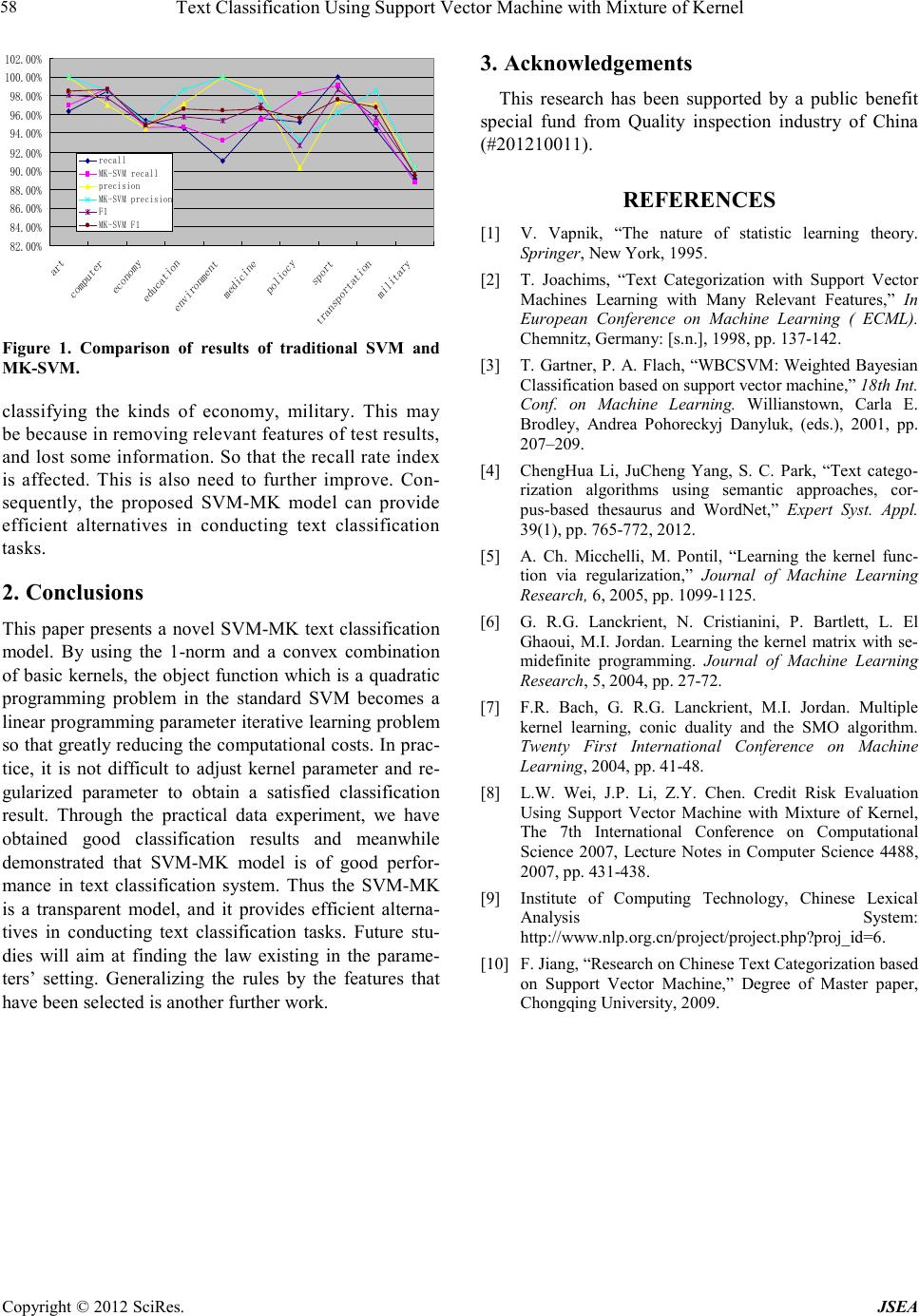
Text Classification Using Support Vector Machine with Mix ture of Kernel
Copyright © 2012 SciRes. JSEA
58
82.00%
84.00%
86.00%
88.00%
90.00%
92.00%
94.00%
96.00%
98.00%
100.00%
102.00%
recall
MK-SVM recall
precision
MK-SVM precision
F1
MK-SVM F1
Figure 1. Comparison of results of traditional SVM and
MK-SVM.
classifying the kinds of economy, military. This may
be because i n remo ving rele vant feat ur es of te st r e s ul ts,
and lo st so me infor mation. So that the recall rate index
is affected. This is also need to further improve. Con-
sequently, the proposed SVM-MK model can provide
efficient alternatives in conducting text classification
tasks.
2. Conclusions
This paper presents a novel SVM-MK text classification
model. By using the 1-norm and a convex combination
of basic kernels, the object function which is a quadratic
programming problem in the standard SVM becomes a
linea r pro grammi ng paramete r iterative learning problem
so that greatly reducin g the computational costs. In prac-
tice, it is not difficult to adjust kernel parameter and re-
gularized parameter to obtain a satisfied classification
result. Through the practical data experime n t , we have
obtained good classification results and meanwhile
demonstrated that SVM-MK model is of good perfo r-
mance in text classification syste m. Thus the SVM-MK
is a transpar ent model, and it provides efficient alterna-
tives in conducting text classification tasks. Future stu-
dies will aim at finding the law existing in the parame-
ters’ setting. Generalizing the rules by the features that
have been selected is another f urther wo rk.
3. Acknowledgements
This research has been supported by a public benefit
special fund from Quality inspection industry of China
(#201210011).
REFERENCES
[1] V. Vapnik, “The nature of statistic learning theory.
Springer, New York, 1995.
[2] T. Joachims, “Text Categorization with Support Vector
Machines Learning with Many Relevant Features,” In
European Conference on Machine Learning ( ECML).
Chemnitz, Germany: [s.n.], 1998, pp. 137-142.
[3] T. Gartner, P. A. Flach, “WBCSVM: Weighted Bayesian
Classification based on support vector machine,” 18th Int.
Conf. on Machine Learning. Willianstown, Carla E.
Brodley, Andrea Pohoreckyj Danyluk, (eds.), 2001, pp.
207–209.
[4] ChengHua Li, JuCheng Yang, S. C. P ar k, “Text catego-
rization algorithms using semantic approaches, cor-
pus-based thesaurus and WordNet,” Expert Syst. Appl.
39(1), pp. 765-772, 2012.
[5] A. Ch. Micchelli, M. Pontil, “Learning the kernel func-
tion via regularization,” Journal of Machine Learning
Research, 6, 2005, pp. 1099-1125.
[6] G. R.G. Lanckrient, N. Cristianini, P. Bartlett, L. El
Ghaoui, M.I. Jordan. Learning the kernel matrix with se-
mide finite programming. Journal of Machine Learning
Research, 5, 2004, pp. 27-72.
[7] F.R. Bach, G. R.G. Lanckrient, M.I. Jordan. Multiple
kernel learning, conic duality and the SMO algorithm.
Twent y First International Conference on Machine
Learning, 2004, pp. 41-48.
[8] L.W. Wei, J.P. Li, Z.Y. Chen. Credit Risk Evaluation
Using Support Vector Machine with Mixture of Kernel,
The 7th International Conference on Computational
Science 2007, Lecture Notes in Computer Science 4488,
2007, pp. 431-438.
[9] Institute of Computing Technology, Chinese Lexical
Analysis System:
http://www.nlp.org.cn/project/project.php?proj_id=6.
[10] F. Jiang, “Research on Chinese Text Categor ization based
on Support Vector Machine,” Degree of Master paper,
Chongqing University, 2009.